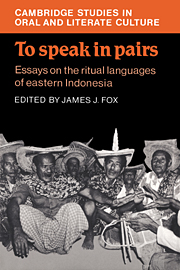Book contents
- Frontmatter
- Contents
- Illustrations
- The contributors
- Acknowledgements
- Introduction
- 1 Etiquette in Kodi spirit communication: the lips told to pronounce, the mouths told to speak
- 2 Method in the metaphor: the ritual language of Wanukaka
- 3 Li'i marapu: speech and ritual among the Wewewa of west Sumba
- 4 The Pattern of Prayer in Weyéwa
- 5 Fashioned speech, full communication: aspects of eastern Sumbanese ritual language
- 6 Manu Kama's road, Tepa Nilu's path: theme, narrative, and formula in Rotinese ritual language
- 7 The case of the purloined statues: the power of words among the Lionese
- 8 The journey of the bridegroom: idioms of marriage among the Endenese
- 9 A quest for the source: the ontogenesis of a creation myth of the Ata Tana Ai
- 10 The Tree of Desire: A Toraja ritual poem
- Notes
- References
- Index
10 - The Tree of Desire: A Toraja ritual poem
Published online by Cambridge University Press: 19 October 2009
- Frontmatter
- Contents
- Illustrations
- The contributors
- Acknowledgements
- Introduction
- 1 Etiquette in Kodi spirit communication: the lips told to pronounce, the mouths told to speak
- 2 Method in the metaphor: the ritual language of Wanukaka
- 3 Li'i marapu: speech and ritual among the Wewewa of west Sumba
- 4 The Pattern of Prayer in Weyéwa
- 5 Fashioned speech, full communication: aspects of eastern Sumbanese ritual language
- 6 Manu Kama's road, Tepa Nilu's path: theme, narrative, and formula in Rotinese ritual language
- 7 The case of the purloined statues: the power of words among the Lionese
- 8 The journey of the bridegroom: idioms of marriage among the Endenese
- 9 A quest for the source: the ontogenesis of a creation myth of the Ata Tana Ai
- 10 The Tree of Desire: A Toraja ritual poem
- Notes
- References
- Index
Summary
Introduction
Sulawesi, Indonesia's third largest island, lies between Borneo and the Moluccas, with its peninsular arms extending in every direction. The fertile plains of the island's southwestern arm rise into rugged mountains formed of limestone and volcanic tuffs in the north. These mountains, through which the Sa'dan River and its tributaries flow, are the homeland of 320,000 Sa'dan Toraja people. At altitudes between 3000 and 4000 feet, the Toraja cultivate rice in irrigated fields carved into the mountainside, supplemented by cassava, corn, and Arabica coffee as a cash crop. Water buffalo, pigs, and chickens are raised for both food and ritual purposes. Recently, international tourism and labour outmigration have begun to play a role in the economy. Religious change, begun in the Dutch colonial period with Protestant missionising, has accelerated since Indonesian independence as the Toraja increasingly convert to Christianity. Language is changing as well. Although all Toraja speak a Malayo-Polynesian language known to the Dutch as Tae′ (after the local word for ‘no’), and known to the Toraja simply as basa Toraya (‘Toraja language’), most younger educated Toraja also speak Indonesian, a trend likely to continue as education and outmigration increase.
The Toraja are famous in Western travel brochures and throughout Indonesia for their exuberant ritual life. In particular, spectacular funerals with hundreds or thousands of guests, scores of sacrificed buffalo and pigs, and dizzying cliff burials have attracted the attention of adventurers, film-makers, and scholars. Less attention, however, has been paid to the speech that plays a vital role in this ritual tradition. In spite of changes occurring throughout Toraja culture, speech continues to be a source of power and pleasure, in both ritual and everyday life.
- Type
- Chapter
- Information
- To Speak in PairsEssays on the Ritual Languages of eastern Indonesia, pp. 282 - 305Publisher: Cambridge University PressPrint publication year: 1988
- 6
- Cited by

